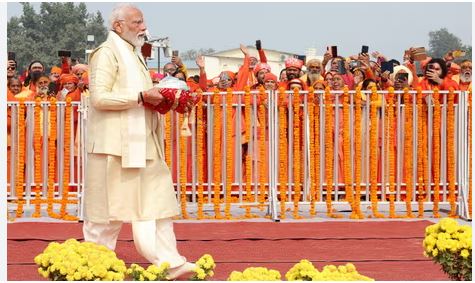By Rajan Narayan
THE “prana pratishtha” or consecration of the new Ram Mandir in Ayodhya on January 22, 2024 also marks the demolition of the Indian Constitution. Ironically, Republic Day which celebrates the Constitution was adopted on January 26, 1948. The Preamble to the Constitution declares that the country is a secular democratic country called India. The Constitution does mention Bharat as an alternative name to India but it is secondary to India. The Constitution unequivocally declares that India is a secular democratic country.
This does not mean we are a godless country. There is no ban on religious symbols, unlike in France. In France sporting any religious symbols at educational institutions and work places is strictly banned. But India believes in freedom of religion. Every religion has a right to be practiced and promote itself. Conversion has never been explicitly banned in India.
RAGHUPATI RAGHAV RAJA RAM…
THE religious harmony which prevailed in the country is epitomised in one of Mahatma Gandhi’s favourite bhajan, “Raghupati ragav raja Ram, pati tapavan Sitaram…” The BJP and Hindutva brigade are chanting the first two lines with fervour and a Hindu from Europe has set the bhajan to disco music driving Ram bhakt into a frenzy. The Hindutva gang has forgotten the next two lines of the bhajan which go “…Ishwar Allah tero naam, sabko sampati de bhagwan…” These two lines emphasise the communal harmony which been a landmark in India mostly post-independence.
Admittedly there were communal riots in the wake of Partition and later in and particularly in Bengal. East Bengal became a part of Pakistan and it was subsequently liberated by the late prime minister, Indira Gandhi, in the Bangladesh Liberation War of 1971. Earlier when the riots raged in Bengal in 1946 Mahatma Gandhi had undertaken his indefinite fast in the then Calcutta. The fast stopped the riots with both Hindus and Muslims surrendering their arms. But later Gandhi was assassinated by Nathuram Godse on January 30, 1948.
SECULAR INDIA
HOWEVER, the first prime minister of India Jawarharlal Nehru was firmly committed to secularism of the country. Maulana Azad was a senior member of the Nehru cabinet. Nehru extended protection to minority Muslim and Christian communities. Indeed, when the communist government in Kerala threatened to nationalize and take over the Christian educational institutions Nehru sacked the Namboodri government. The Aligarh Muslim University was started during the tenure of Jawarharlal Nehru.
The Hindus in India were not fanatical. Hindu fundamentalism was not encouraged by Nehru. Nor all the subsequent prime ministers including Atal Behari Vajpayee, the first BJP prime minister. Vajpayee respected other religions. It was LK Advani who is the high priest of the Hindutva movement. So in 1992 he launched the Ram Janmabhoomi Yatra which started from Gujarat. The only chief minister who had the guts to stop the yatra was Laloo Prasad Yadav.
Over 15 lakh kar sevak were reported to have entered Ayodhya. Till then the Ram Janmabhoom was still disputed. With the help of the BJP Chief Minister of Uttar Pradesh Kalyan Singh the kar sevak demolished the Babhi Masjid on December 6, 1992.
The Ram Janbhoomi movement was revived by the Hindu Mahasabha and the RSS. They were alleged to have planted a statue of the child Ram in the Babri Masjid. The story goes that a police constable at Ayodhya police outpost had a vision. He say a flash of light and the image of a five-year-old Ram. The BJP claimed that the idol miraculously appeared within the Babri Masjid. This was used to demand the right of Hindus to go inside the Babri Masjid to pray to Ram Lalla. The Muslim community appealed to the district magistrate against allowing permission to Hindus to worship at the Babri Masjid. The masjid was then locked up and Hindus only allowed to pray from outside.
The new magistrate defied the orders of Prime Minister Nehru in 1949. He allowed the Hindus to enter the Babri Masjid. After the demolition of the masjid in 1992 the BJP insisted the masjid was built on the site of the original Ram Mandir. The BJP insisted that Ayodhya was the birthplace of Sri Ram After a long legal battle the Supreme Court on technical grounds agreed with the BJP claim in 2019.
HINDUTVA TRIUMPH
THIS cleared the decks for the construction of the Ram Temple in Ayodhya. Narendra Modi came to power 2014 on the promise of building the Ram Temple at Ayodhya. The Ram Temple is being projected as a triumph of Hindutva. The saffron brigade is claiming that it marks the renaissance of Hinduism. Orthodox Hindus led by the Shankarcharya are very upset about Narendra Modi performing the rituals of the new temple at its inauguration or consecration on January 22, 2024. They are shocked that he touched the idol. This is considered the preserve of Brahmin priests in the sense that Ayodhya represents a caste which rebuffed Brahmins. Ram was a Kshtriya king but the boatman who was “Kevat” ferried him across the sea to Sri Lanka and he also has a place in the Ayodhya Temple we understand.
REPUBLIC DAY!
NEVER before has there been such a frenzy over such a religious event. The grand prana pratishta or consecration of the Ram Mandir in Ayodhya by Prime Minister Narendra Modi has completely overshadowed Republic Day, just four days away as we write this will be celebrated on January 26 as usual presumably.
